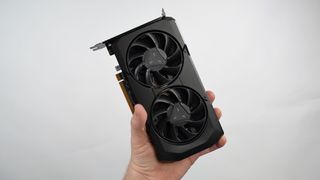AMD is taking so long to release the RX 7800 XT that we’re reduced to simulating it
With the launch of the AMD Radeon RX 7900 XTX, RX 7900 XT, and RX 7600, gamers everywhere are impatiently waiting for even just an announcement around AMD’s remaining GPUs — the RX 7800 series and RX 7700 series — and it’s gotten to the point where one tester had to simulate the possible performance of the RX 7800 XT instead.
The tests conducted by Igor Wallossek of Igor’s Lab use the AMD Pro Radeon W7800 with a number of tricks to try and put it in line with possible specs for the RX 7800 XT, of which we’ve heard very little.
Importantly, the Pro Radeon W7800 uses the same Navi 31 GPU as the RX 7900 XTX and RX 7900 XT, which the RX 7800 XT will likely use as well, but that isn’t guaranteed. The Navi 32 GPU still hasn’t been revealed by AMD, and this could be the GPU used by the RX 7800 XT, which would definitely skew the results a good bit.
There is also the issue of drivers, clock speeds, chiplet design, and all sorts of other differences that distinguish a Pro Radeon card from a gaming Radeon RX card, so Wallossek’s results definitely need to be taken with a massive boatload of salt.
All that said, he found that the simulated RX 7800 XT was about 4% better at 1080p, 8% better at 1440p, and 12.5% better at 4K than the RX 6800 XT. That is obviously not a significant improvement, with only the 4K performance being worthy of being called “better” in practical terms.
But, honestly, the point here is not to actually measure the performance of the RX 7800 XT, which these tests absolutely do not do. The point is what these tests tell us about the market and AMD’s missing GPUs.
AMD’s gamble on the early release of the RX 7600 paid off, but it’s time to move on
The simulated specs on the Pro Radeon W7800 are about as useful as a crystal ball in terms of what it tells us about the RX 7800 XT, and in more ways than one. On the one hand, Igor’s Lab’s simulation is interesting as a modding exercise but has so many caveats attached that it can’t in any way be predictive of the RX 7800 XT’s real performance.
The fact that we have to resort to a crystal ball at all is more pertinent since AMD has been awfully quiet about its 7800 series and 7700 series, and with no leaked benchmarks or other information to go on, guesswork is really all we have at this point.
I was very adamant back in February of this year that AMD skip the typical moving-down-the-stack release cadence and release its RX 7600 series GPUs ahead of the RX 7800- and RX 7700 series. I argued then that it was a smart play to undercut Nvidia by releasing a next-gen budget-friendly GPU ahead of expectations to sell to arguably the biggest and most underserved market, which is gamers without a whole lot of cash to spend. There’s always money to be made selling the best cheap graphics card on the market.
That seems to have paid off for AMD as sales of the RX 7600 appear to be outpacing the RTX 4060 Ti (no need to thank me, Dr. Su. Advice on behalf of gamers is always freely given). With that win under its belt though, it’s now time for AMD to look at the part of the stack we skipped, starting with the RX 7800 XT.
Where the %$^# is the AMD Radeon RX 7800 XT?
There is going to be a lot of enthusiast interest in the RX 7800 XT, as well as the RX 7700 XT, and the less we heard about these cards the more we’re just going to baselessly speculate, and that’s not a good thing for Team Red.
The one thing you don’t want to do is let gamers’ speculations get out ahead of what you are actually going to be releasing. The longer we go without something to keep those expectations in check, the more likely we are to overestimate the performance of these two (or four) cards, which will only lead to disappointment at launch if the cards fail to meet these inflated expectations.
I’m not saying AMD needs to make an early announcement before it’s ready, but it really does need to “accidentally” leave its internal test benches connected to the internet and start doing some benchmarks that can find their way into databases online (and subsequently into the press) to help moderate expectations.
Hell, you could even undervolt the card, run 3DMark Time Spy and forward the results to a Twitter leaker or run Geekbench’s Compute benchmark a bunch of times while uploading the results, and lower our performance expectations only to blow those out of the water once we can actually get the final product in hand for review.
Honestly, we prefer anything but dead silence on what could be one of the best graphics cards of this generation. Feed the hogs, AMD. We need sustenance!

